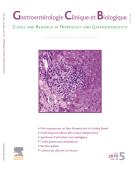Functional biostructure of colonic microbiota (central fermenting area, germinal stock area and separating mucus layer) in healthy subjects and patients with diarrhea treated with Saccharomyces boulardii - 01/10/10
 , V. Loening-Baucke a, S. Kirsch b, Y. Doerffel c
, V. Loening-Baucke a, S. Kirsch b, Y. Doerffel cSummary |
The colonic content can be compared to a spatially structured high output bioreactor composed of three functionally different regions: a separating mucus layer, a germinal stock area, and a central fermenting area. The stool mirrors this structure and can be used for diagnosis in health and disease. In a first part, we introduce a novel method based on fluorescence in situ hybridization (FISH) of sections of punchedout stool cylinders, which allows quantitatively monitor microbiota in the mucus, the germinal stock and the central fermenting areas. in a second part, we demonstrate the practical implementation of this method, describing the biostructure of stool microbiota in healthy subjects and patients with chronic idiopathic diarrhea treated with Saccharomyces boulardii. Punched stool cylinders from 20 patients with chronic idiopathic diarrhea and 20 healthy controls were investigated using fluorescence in situ hybridization. Seventy-three bacterial groups were evaluated. Fluctuations in assembly of 11 constitutive bacterial groups were monitored weekly for 3 weeks prior to, 3 weeks during, and 3 weeks after oral Saccharomyces boulardii supplementation. Typical findings in healthy subjects were a 5-60 μm mucus separating layer; homogeneous distribution and fluorescence, high concentrations (>10 × 1010 bacterial/mL) of the three habitual bacterial groups: Bacteroides, Roseburia and Faecalibacterium prausnitzii; and low concentrations of the occasional bacterial groups. The diarrhea could be described in terms of increased separating effort, purging, decontamination, bacterial substitution. Typical findings in diarrhea were: increased thickness of the protective mucus layer, its incorporation in the stool, absolute reduction in concentrations of the habitual bacterial groups, suppression of bacterial metabolism in the central fermenting area (hybridization silence), stratification of the stool structure by watery ingredients, and substitutive increase in the concentrations of occasional bacterial groups. The microbial and clinical symptoms of diarrhea were reversible with Saccharomyces boulardii therapy. The structure-functional analysis of stool microbiota allows to quantitatively monitor colonic malfunction and its response to therapy. Saccharomyces boulardii significantly improves the stool biostructure in patients with chronic idiopathic diarrhea and has no influence on the stool microbiota in healthy subjects.
Le texte complet de cet article est disponible en PDF.Résumé |
Le contenu du côlon peut être comparé à un bioréacteur à haut débit doté d’une structure spatiale comportant trois régions fonctionnellement différentes : une couche de mucus séparatrice, une zone germinale de réserve et une zone centrale de fermentation. Les selles reflètent cette structure et peuvent être utilisées comme un outil diagnostique chez le sujet sain ou malade. Dans la première partie, nous introduisons une méthode innovante fondée sur l’étude par hybridation fluorescente in situ (FISH) de coupes de selles prélevées par carottage, ce qui permet une évaluation quantitative du microbiote dans le mucus, dans la zone de réserve germinale et dans la zone centrale de fermentation. Dans une seconde partie, nous démontrons la mise en œuvre pratique de cette méthode en décrivant la biostructure du microbiote fécal chez des sujets sains et chez des patients atteints de diarrhée chronique idiopathique traités par Saccharomyces boulardii. Des carottes de selles de 20 patients souffrant de diarrhée chronique idiopathique et de 20 témoins sains ont été étudiées par la méthode de FISH. Soixante-treize groupes bactériens ont été évalués. Les fluctuations dans la combinaison de 11 groupes bactériens constitutifs ont été observées chaque semaine pendant trois semaines avant, trois semaines pendant et trois semaines après une supplémentation orale par Saccharomyces boulardii. Les constatations typiques des sujets sains étaient une couche muqueuse séparatrice de 5-60 μm, une distribution et une fluorescence homogènes, de fortes concentrations (>10 × 1010 bactéries/mL) des trois groupes bactériens habituels - Bacteroides, Roseburia et Faecalibacterium prausnitzii - et de faibles concentrations des groupes bactériens occasionnels. La diarrhée a pu être décrite en termes d’augmentation de l’effort de séparation, d’épuration, de décontamination et de substitution bactérienne. Les constatations caractéristiques de la diarrhée étaient une augmentation d’épaisseur de la couche muqueuse protectrice, son incorporation aux selles, une réduction absolue des concentrations des groupes bactériens habituels, une inhibition du métabolisme bactérien dans la zone centrale de fermentation (disparition du signal d’hybridation), une stratification de la structure des selles par des ingrédients aqueux et une augmentation compensatoire des concentrations des groupes bactériens occasionnels. Les symptômes microbiens et cliniques de la diarrhée étaient réversibles après le traitement par Saccharomyces boulardii. L’analyse du rapport structure/fonction du microbiote fécal permet de caractériser quantitativement la dysfonction colique et sa réponse au traitement. Saccharomyces boulardii améliore significativement la biostructure des fèces au cours de la diarrhée chronique idiopathique et n’a pas d’effet sur le microbiote fécal des sujets sains.
Le texte complet de cet article est disponible en PDF.Abbreviations : FISH - fluorescence in situ hybridization, Cy3, Cy5, FITC, DAPI - different fluorescent dyes corresponding to green, orange, dark red and blue colours, Alcian PAS, DSS
Plan
| A reprint of the french translation of this article is available on request. |
Vol 34 - N° S1
P. S79-S92 - septembre 2010 Retour au numéroBienvenue sur EM-consulte, la référence des professionnels de santé.

